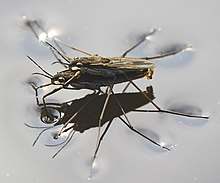Heteroptera
| Heteroptera | |
|---|---|
 |
|
| Barisus cercius | |
| Scientific classification | |
| Kingdom: | Animalia |
| Phylum: | Arthropoda |
| Class: | Insecta |
| Order: | Hemiptera |
| Suborder: |
Heteroptera Latreille, 1810 |
| Infraorders | |
The Heteroptera are a group of about 40,000 species of insects in the order Hemiptera. Sometimes called "true bugs", that name more commonly refers to the Hemiptera as a whole, and "typical bugs" might be used as a more unequivocal alternative since among the Hemiptera, the heteropterans are most consistently and universally termed "bugs". "Heteroptera" is Greek for "different wings": most species have forewings with both membranous and hardened portions (called hemelytra); members of the primitive Enicocephalomorpha have completely membranous wings.
The name "Heteroptera" is used in two very different ways in modern classifications; in Linnean nomenclature, it commonly appears as a suborder within the order Hemiptera, where it can be paraphyletic or monophyletic depending on its delimitation. In phylogenetic nomenclature, it is used as an unranked clade within the Prosorrhyncha clade which in turn is in the Hemiptera clade. This results from the realization that the Coleorrhyncha are just "living fossil" relatives of the traditional Heteroptera, close enough to them to be united with that group.
The Gerromorpha and Nepomorpha contain most of the aquatic and semiaquatic members of the Heteroptera, while nearly all of the remaining groups that are common and familiar are in the Cimicomorpha and Pentatomomorpha.
The use of the name "Heteroptera" has had the rank of order, dating back to 1810 by Latreille. Only recently has it been relegated to a subsidiary rank within a larger definition of Hemiptera, so many reference works still include it as an order. Whether to continue treating it as a suborder is still a subject of some controversy, as is whether the name itself should ever be used, although three basic approaches ranging from abolishing it entirely to maintaining the taxonomy with a slight change in systematics is proposed, two of which (but not the traditional one) agree with the phylogeny. The competing classifications call for a preference for two suborders versus one when the "living fossil" family Peloridiidae is taken into consideration:
...
Wikipedia
